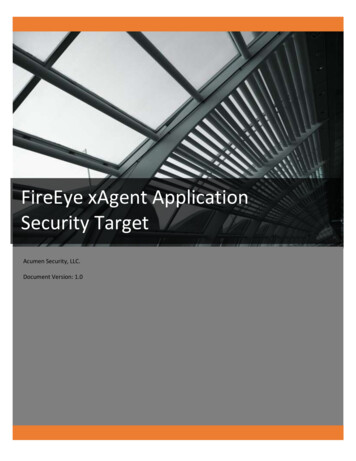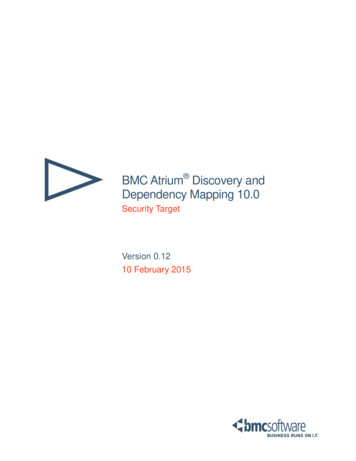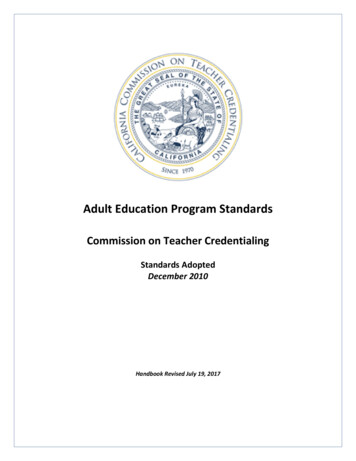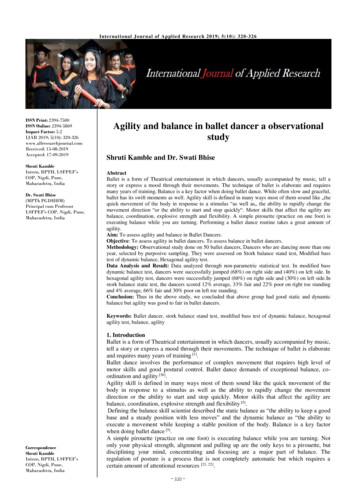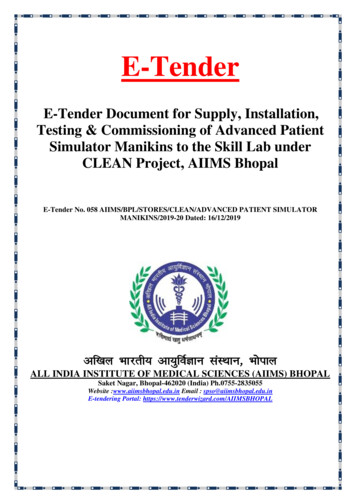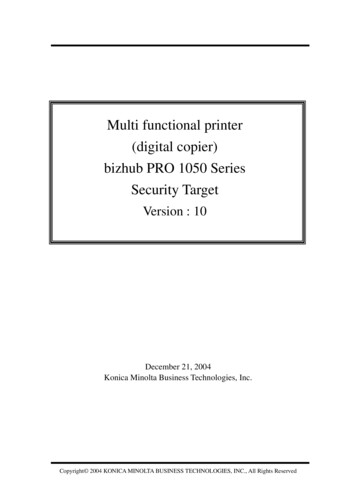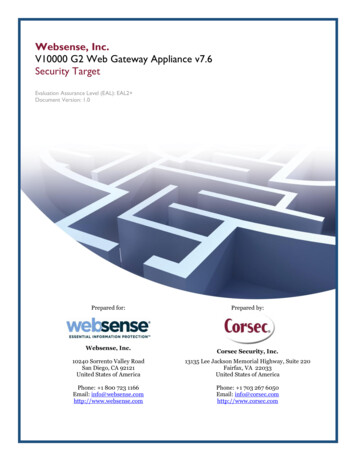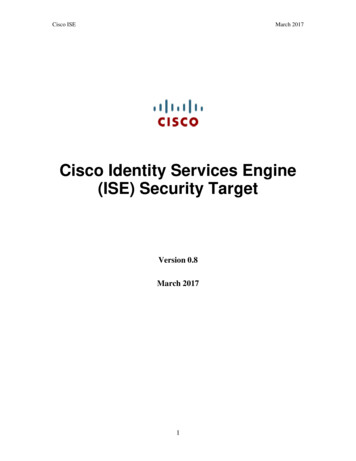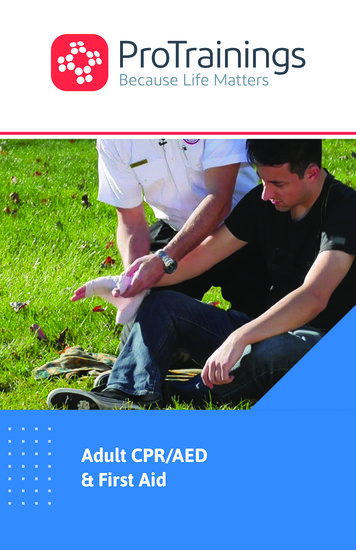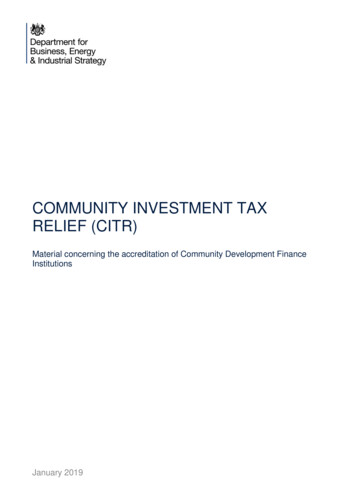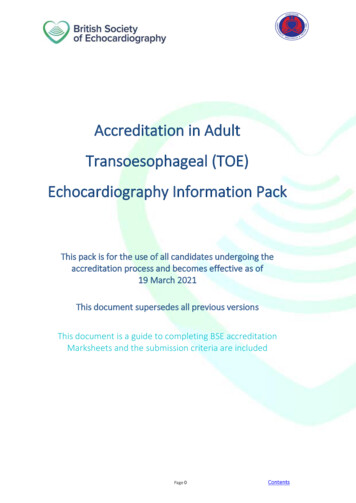
Transcription
Accreditation in AdultTransoesophageal (TOE)Echocardiography Information PackThis pack is for the use of all candidates undergoing theaccreditation process and becomes effective as of19 March 2021This document supersedes all previous versionsThis document is a guide to completing BSE accreditationMarksheets and the submission criteria are includedPage 0Contents
Table of ContentsTable of Contents. 1Welcome message from Accreditation Chairs . 2Introduction and Aims . 3Summary of process requirements. 3At the practical assessment, you should submit: . 4Extensions and Exam fees . 4Details of written assessment and practical assessments . 4Theory Section . 5Echo Reporting section . 5Practical assessment . 6Logbook . 6Viva Case Submission . 8Outcomes and process for re-attempts . 10Appendix 1 -Suggested Reading List . 11Appendix 2 -Training syllabus for BSE accreditation . 13Appendix 3 Written Examination: Example Theory Questions. 27Appendix 4 - Written Examination: Example Echo Reporting section . 28Appendix 5: Pearson VUE – Guidance Notes . 29Appendix 6 - Curriculum Based Competency Assessment Tool . 31Appendix 7 -Suggested format for a report . 35Appendix 8 – Report Format . 36Appendix 9 –Transesophageal echocardiographic Proficiency: Summary Sheet . 37Appendix 10 – Example of Station 1 Assessment forms to be used at the Practical Assessment . 38Appendix 11 – Example of Station 2 Assessment forms to be used at the Practical Assessment . 40Appendix 12- Examples of Station 3 Assessment forms to be used at the practical assessment . 46Appendix 13 –Mentor statement to accompany the Practical Assessment . 48Appendix 14 – BSE Policy on the Non-anonymisation of Patient Data. 49Appendix 15– Final checklist for logbooks . 51Appendix 16- Logbook portal user guide . 52Page 1Contents
Welcome message from Accreditation ChairsDear Candidate,Welcome to the British Society of Echocardiography. The transoesophageal echocardiographyaccreditation process represents a joint venture between the British Society of Echocardiography (BSE)and the Association of Cardiothoracic Anaesthetists (ACTACC).The process is primarily offered as a service to the Members of both these specialist societies. It isdesigned to accommodate the requirements of cardiologists, sonographers, anaesthetists, intensivistsand cardiac surgeons. It is important that you read all the information carefully before commencingyour specific speciality logbook.The written section of the Assessment is held up to twice each year in various venues around the UKand Republic of Ireland. The practical assessment will be held approximately four times per year in avariety of locations- depending on candidate demand. Please visit www.bsecho.org for onlineregistration details.We would encourage BSE members to undertake the relevant accreditation process, with the ultimateaim of achieving and maintaining a high standard of clinical echocardiography for the benefit of ourpatients.The accreditation process is regulated to ensure a high level of proficiency and professional standard.We aim to make it possible for as many members to achieve accreditation. A list of accreditedmembers is maintained on the BSE website.Please let us know if we can assist you in this process in any specific way, or if you have constructivefeedback to offer the accreditation committee then please just get in touch.Good luck with your accreditation process.Best wishes,Sadie BennettChair, BSE Accreditation CommitteePage 2Contents
Introduction and AimsAccreditation is run as a service for members of the British Society of Echocardiography and is not acompulsory or regulatory certificate of competence or excellence. Accredited echocardiographers areexpected to be able to perform and report echocardiographic studies unsupervised.The Accreditation process is involved predominantly with transoesophageal echocardiography. However,an understanding of transthoracic echocardiography is also necessary because the two approaches arecomplementary. Accreditation is a minimum requirement and cannot be regarded as a guarantee ofcompetence.The Accreditation process comprises a written exam, (theory and case reporting sections) and a practicalassessment comprising a live observed practical assessment on a simulator, review of the requiredlogbook and a review of selected Viva echo cases performed to a high standard.Echo skills can only be maintained by continued education and practical involvement in echocardiography.The importance of this is underlined by limiting Accreditation to 5 years after which re accreditation mustbe sought. Ongoing BSE membership is a requirement for maintaining accreditation.Summary of process requirements You must be a member of the British Society of EchocardiographyYou should address all queries regarding accreditation to: BSE Accreditation Department,address details and online registrations are available via www.bsecho.org. Tel: 0208 065 5794(lines open from 09:00-17:00 Mon-Fri- excluding UK public holidays), Email:accreditation@bsecho.org.You must pass the written assessment before attending the practical assessment.The practical assessment cases and logbook should be collected over a period of no more than24 months from the written examination with the practical assessment being taken two monthsafter the collection end date or the next available exam date. Therefore, cases can be collectedbefore the written exam, but the total time for cases to be collected remains 24 months.Each candidate for accreditation must contact a suitably qualified supervisor who undertakes totrain and supervise and to arrange visits to other centers if there are difficulties obtaining anadequate case-mix locally.One or two supervisors at each center have been approved by the BSE based on demonstrationof competence at echocardiography and evidence of continuing practice.To maintain supervisor status it will be necessary for the supervisor him or herself to pass theBSE accreditation process. Mentors can be approached through the BSE, please contact theaccreditation department for more information.There is no general (or ‘grandfather’) exemption from BSE TOE accreditation.Page 3Contents
At the practical assessment, you should submit: Five full cases accompanied by reports signed by yourselfA logbook containing the 125 reports of a specific case-mix or 75 cases if you hold BSE TTE, CriticalCare or EACVI Accreditation.Reports to be uploaded and submitted via the logbook portal. Mentor, summary and statementsare to be completed via the portal.Fully subscribed BSE members can request access to the portal before sitting the writtenexamination by emailing accreditation@bsecho.org.Extensions and Exam fees Extensions to the 24-month deadline may be granted in accordance with the extensions policy.Extension requests forms must be submitted before the submission deadline. Extension requestforms (along with all other BSE applications forms) can be found www.bsecho.org. Requestsreceived after the case deadline may not be granted.Extensions are not guaranteed. A non-refundable charge of 100 will be made for each extensionrequest regardless of the outcome. A fee of 250 is charged for the complete accreditation process. This fee is payable, in advance uponregistration for the written section of the examination and will also cover the practical assessment.There is a non-refundable booking fee of 20 to pay upon registering for a secured placement at thepractical assessment. All registrations are online. Candidates who are unsuccessful in the written section of the examination will be charged areduced fee of 125 to re-sit this section. This reduced fee only applies to candidates who re-sitthe examination within two sittings of the unsuccessful attempt (in 12 months). A re-attempt atthe practical assessment is also subject to a fee of 125. Candidates are entitled to one re-attempt at the practical assessment. The full training syllabus is available in Appendix 2. Appeals process can be accessed via www.bsecho.org. Candidates can appeal the decision on apractical assessment result and a reaccreditation result. There is no appeals process for the writtensection of the examination.Details of written assessment and practical assessmentsWritten assessmentThe written assessment is held once a year. The examinations are held at various Pearson VUE centresacross the UK, Republic of Ireland, and some overseas locations. See Appendix 5 for further informationon registrations for the written exams.The written assessment is conducted under formal examination conditions. It is comprised of two parts:a Theory section and a Reporting section. A suggested reading list is available in Appendix 1.Page 4Contents
The assessment comprises 100 Single Best Answer Questions covering the syllabus in Appendix 2.The questions test knowledge of echocardiographic findings with some additional questions on basiccardiology and physics.The first 50 Multiple Choice Questions (MCQs) will be based on video clips/still images and the next 50MCQs will be based on theory. Each MCQ comprises of a main stem followed by 5 options relating tothe stem. The single best answer should be chosen. Some example questions are provided in Appendix3. The subject matter reflects the spectrum of clinical practice according to both frequency andtechnical complexity. Thus, valve disease is more frequently represented than ischaemic disease since,though seen less commonly in clinical practice, it presents a greater challenge to theechocardiographer. Both parts of the examination will be computer marked - guidelines in Appendix 5.In the written assessment it is necessary to pass both the multiple choice and imaging questions at thesame exam sitting. The pass mark for the Theory Section is approximately 70% and for the ReportingSection is approximately 80%. These may vary at the discretion of the Chief Examiner followingmoderation. There is no bar to re-sitting the written assessment any number of times.Accreditation will only be awarded once a candidate has also successfully completed the practicalassessment (logbook and cases). A satisfactory performance at the written assessment alone does notallow ‘partial accreditation‘.Theory SectionThis consists of 50 Single Best Answer MCQs covering the syllabus in Appendix 2.The theory section will last 60 minutes.Each MCQ comprises a main stem followed by 5 options related to the stem. The single best answershould be chosen. Some example questions are provided in Appendix 3.The Theory examination will be marked 1 for correct answers, 0 for incorrect or unansweredquestions. There is no negative marking.Echo Reporting sectionThis consists of 50 Single Best Answer MCQs based on an echo images, whether videos, image frames,Doppler or other echo data.The Echo Reporting section will last 90 minutes.They reflect the range of clinical material seen in routine echocardiographic practice.Each MCQ comprises a main stem followed by 5 options relating to the stem. The single best answershould be chosen. Some example questions are provided in Appendix 4.The Reporting section will be marked 1 for correct answers, 0 for incorrect or unanswered questions.There is no negative marking.Page 5Contents
Practical assessmentAll candidates will be required to attend a practical assessment within 26 months of beginning to collecttheir cases (i.e. within two months of their case collection deadline). The written examination musthave been passed at anytime during the collection period, before attending. The Practical assessmentwill be held up to four times per year- depending on candidate demand.Dates and locations will be announced on the Practical Registrations section of www.bsecho.org.Candidates will need to select an available date and register online. Registration will openapproximately three months before the assessment date. Upon receiving confirmation of an examplacement, candidates will be given an assessment time.The assessment will consist of 3 Stations. Station 1 will assess the Logbook.On attendance at the exam, your logbook portal reference will be activated for the examiners who willreview your logbook whilst you attend Station 2.Feedback for Station 1 will be given after you have completed Stations 2 & 3.Logbooks and cases must be fully anonymised – please read the BSE Policy on the Non-Anonymisationof Patient data in Appendix 14 breach of this policy will result in an automatic fail.Logbook submissions are via portal unless agreed otherwise by the chief examiner.LogbookThe Logbook should comprise details of 125 Transoesophageal echocardiography cases personallyperformed and reported by you during the specified period of 24 months, or 75 cases over the sametime period if you hold BSE or EACVI TTE/TOE Accreditation). It is not acceptable to include casesreported by you that have been performed by someone else. Certificate evidence of EACVI TTE/TOEaccreditation, if held, must be brought with you to the examination.The format for the Logbook is a set of copies of actual, anonymized, clinical reports submittedvia the BSE online logbook portal.The reports should ensure: All patient data has been removed including full date of birth, name and address. See Appendix 14.All cases have been collected in accordance with local requirements for data protection, i.e. yourtrust policy.The inclusion of cavity and Doppler measurements, objective observations and a comment –see Appendix 7 and 8.The signature (or e-signature) and full name of the candidate are included. At least the final 50cases should be reported primarily by the candidate alone although they may be checked byanother operator.In some cases, Trust Policy dictates that reports are signed by Accredited Echocardiographers only.In this case, reports signed by the supervising echocardiographer may be included in the logbookbut should be countersigned by both the candidate and the supervising echocardiographer toconfirm that the trainee has produced the report. An advisory letter from the head of departmentor supervisor should also be included in the submission.Page 6Contents
The studies should reflect the normal case-load of a general adult department and should include atleast one example of the following case mix: Mitral repairSevere mitral valve regurgitationEndocarditisBasic adult congenital heart disease (e.g. ASD, VSD or pulmonary stenosis)Aortic pathology (e.g. dissection, aneurysm, intramural haematoma)Abnormal aortic valveHypovolaemia/septic shock assessmentAbnormal prosthetic valveIntracardiac mass including thrombusPericardial effusionLeft ventricular wall motion abnormalityRight ventricular abnormality or pulmonary embolism assessmentNo more than 20 studies should be predominantly normalThe different categories of echoes should be separated. This is done under separate tabs within thelogbook portal.Studies performed before and after bypass i.e. during the same operation, count as one study. A studyperformed for the same patient on separate occasions counts as a separate study.More than one candidate from the same institution is permitted to study the same patient if thediagnosis is unusual but each candidate must independently scan and write their own report.If you have problems finding enough specific cases, discuss this with your mentor who may considerarranging for you to attend a specialised centre.A letter from the supervisor must be submitted with the completed log-book certifying that the studieshave been recorded by the candidate. The Curriculum Based Competency Assessment Tool should alsobe submitted with the logbook (Appendix 6 & 13).Station 2 will assess the Viva case submissions.This will consist of a viva pertaining to the digital echo cases. The digital studies must be accompaniedby their reports. Each study must be submitted as digital loops and still images within a PowerPointpresentation. The dataset for a complete study are listed in Appendix 1.Image acquisition, optimisation, measurements and interpretation will be assessed. Studies must includeone normal study, one case of aortic stenosis (moderate or severe) and three other examples listed inAppendix 11. The candidate must demonstrate the appropriate use of standard Doppler equations andkey measurements appropriate to the pathology.If the candidate is successful at Station 2 they will progress to Station 3. If unsuccessful at station 2, thecandidate can still proceed to the following station for the purpose of summative examination. Thechief examiner will discuss this with the candidate.Page 7Contents
Viva Case SubmissionFive full studies with reports must be brought to the Practical Assessment. The cases must beanonymised. This is the section that is often done least well and is where many candidates fail.Remember that it is assumed you will submit your best cases, so it is worth spending extra time toensure the submission is as good as it can be. Do not choose incomplete studies or patients who arepoorly echogenic. Each case should be a full study performed to the BSE minimum dataset and not afocused study.Please optimise the 2D and Doppler images. Make sure you have optimised the gain setting, sectorwidth, depth, harmonics, focus, sweep speed, Doppler baseline, scale and colour gain. Ensure that thecursors are correctly aligned. Candidates may be failed on just this aspect. Each case should beaccompanied by a full and comprehensive report. This should include a summary that can beunderstood by any non-echocardiographer. If these points are not done well in your submission it maybe assumed that you will have poor quality images on your routine cases.Read the assessment sheet that the assessors will be using for the practical examination. Only includeloops and stills that you wish to be assessed. Ensure that loops and stills with measurements shownmatch the parameters quoted in the report.Each case should be accompanied by a full and comprehensive report including quantitativemeasurements, observations and a conclusion or summary.The following diagnoses and minimum criteria are required:A normal study demonstrating appropriate use of machine settings for optimal imaging and correct useof standard 2-D views as per BSE minimum dataset (mid-oesophageal, transgastric and upperoesophageal), M Mode, CW, PW and Colour Doppler to assess chambers and valves. It is essential todemonstrate accurate measurement of the LV dimensions in at least one case. This would normally bein the normal case but if this is not possible, it is acceptable to provide this in at least one of the othercases.Moderate or severe aortic stenosis (please include a good demonstration of the use of the CW Dopplerprobe in the deep transgastric view/transgastric long axis view). You should also calculate the aorticvalve area using the continuity equation and show all measurements used in the calculation.Moderate or severe mitral or aortic regurgitation which demonstrates quantification of the degree ofregurgitation as per BSE guidelines.It is essential to demonstrate accurate measurement of the LV dimensions in at least one case. Thesemeasurements must be made in diastole and systole in both midoesophageal 4 chamber and 2 chamberviews. Ejection fraction and regional wall motion abnormalities must be described as well.The remaining cases should include an example of one of the following:a)b)c)d)Prosthetic valve with size and type noted and reference to normal values for that specific valveMitral repairEndocarditisIntracardiac mass including thrombus with differential diagnosesPage 8Contents
e)f)g)h)i)Basic adult congenital heart disease (e.g. ASD, VSD or pulmonary stenosis)Aortic pathology (e.g. dissection, aneurysm, intramural haematoma)Hypovolaemia/septic shock assessmentPericardial effusionRight ventricular abnormality or pulmonary embolism assessment In order to ensure that your cases play properly at the assessment you must bring your own laptopto the centre having checked that the cases play on this. The studies must demonstrate all appropriate echocardiographic views and must show themethods of measuring all dimensions on M-mode or 2D and all parameters on Dopplerechocardiography. No case should have any patient-identifiable data. Erasing patient data may not always be possibleafter the examination so please ensure due care is taken to put ‘case 1’ instead of patient’s nameor patient’s personal details. Alternatively, you may wish to use descriptions of pathology such as“aortic stenosis”. You must be able to use the common Doppler equations e.g. continuity equation, calculation of ashunt, estimation of pulmonary artery systolic pressure. Cases that are of high quality may be copied to be used in subsequent BSE written exams.Station 3 will assess the Image acquisition skills (Appendix 12) This will include testing the haptic knowledge and image acquisition skills of the candidate on anecho simulator. Any shortcomings identified in the previous stations will be probed. The simulator can be loaded with different pathologies. The candidate will be asked to acquire a good quality image of a particular view. Not all viewsmay be possible in the available time. If there are concerns with any of the images assessors should question the candidate - if theycan demonstrate appropriate knowledge/competence when questioned this may be sufficient. If the candidate is successful in obtaining the required views to the required standard, they willbe deemed to have passed this section.Page 9Contents
Outcomes and process for re-attemptsIf you are successful at all three stations, you will be deemed to have passed the accreditationprocess and will receive your certificate prior to leaving the assessment. If you are unsuccessful at any station, you will be deemed to have been unsuccessful atthis sitting of the practical assessment. You will be provided with constructive feedbackto facilitate a re-attempt and offered the opportunity to continue to the next station. Any parts of the exam passed at that sitting do not need to be re-attempted at thenext attempt. This only applies to two attempts at the practical within a reasonabletimeframe. To re-attempt, you will need to attend another practical assessment and begin at thestation at which you were unsuccessful and complete all outstanding stationssuccessfully. The timescale allowed for re-attempts will depend on which stations were not passedand the number of Viva cases required to be resubmitted. This will be discussed withyou in the assessment.A second attempt at the practical assessment is subject to a fee of 125. Candidates are entitled to onere-attempt at the practical assessment, after which the written examination must be undertaken again.All re-attempts at the practical assessment including single case and logbook re-submissions, requireattendance by the candidate in person in order to facilitate adequate and useful face to face feedback.Our feedback consistently demonstrates that non-face to face feedback does not adequately equip acandidate to pass at the next sitting.Page 10Contents
Appendix 1 -Suggested Reading ListThe syllabus is set by the Accreditation Committee of the British Society of Echocardiography and ispresented as a guide to candidates.The reading list is provided by the Accreditation Committee of the British Society of Echocardiography.There are many excellent books on echocardiography and some examples are listed below. In addition tothose listed there are many small basic texts which are a useful introduction to the subject.Authoritative textbooks (starting with the simpler texts a suggestion)Practical Perioperative Transesophageal Echocardiography: With Critical Care Echocardiography byDavid Sidebotham, Alan Merry, Malcolm E. Legget · Elsevier/Saunders ISBN 0702034274.A Practical Approach to Transesophageal Echocardiography by Albert C. Perrino, Scott T. ReevesISBN 1451175604Perioperative Two-Dimensional Transesophageal Echocardiography: A Practical Handbook byAnnette Vegas. 1441999523Clinical Manual and Review of Transesophageal Echocardiography, Second Edition by JosephMathew, Madhav Swaminathan, Chakib Ayoub · Mcgraw-Hill. ISBN 0071638075Echocardiography: Guidelines for reporting – a practical handbook Helen Rimington and JohnChambers Taylor & Francis 1998 ISBN 1850700117Feigenbaum‘s Echocardiography William F. Armstrong, Thomas Ryan, Harvey Feigenbaum –2010. ISBN 0781795575Useful review articles:A minimum dataset for a standard transoesophageal echocardiogram: a guideline protocol from theBritish Society of Echocardiography. Richard Wheeler, Richard Steeds, Bushra Rana et al. Echo ResPract. 2015 Dec 1; 2(4): G29–G45.ASE/SCA guidelines for performing a comprehensive intraoperative multiplane transesophagealechocardiography examination: recommendations of the ASECouncil for IntraoperativeEchocardiography and the SCA Task Force for Certification in Perioperative TransesophagealEchocardiography. Shanewise JS, Cheung AT, Aronson S et al. Anesth Analg. 1999 Oct;89(4):870-84.Guidelines for performing a comprehensive transesophageal echocardiographic examination:recommendations from the ASE and SCA. Hahn RT, Abraham T, Adams MS et al. Anesth Analg.2014 Jan;118(1):21-68.Protocols and guidelines are available under the Education tab of www.bsecho.org.Please note that only fully subscribed BSE members are granted with full access to all educationand exam content.Echocardiographic assessment of valve stenosis: EAE/ASE recommendations for clinical practice.Baumgartner H, Hung J, Bermejo J et al. Eur J Echocardiogr. 2009 Jan;10(1):1-25.Recommendations on the Echocardiographic Assessment of Aortic Valve Stenosis: A Focused Updatefrom the European Association of Cardiovascular Imaging and the American Society of Echocardiography.Baumgartner H, Hung J, Bermejo J et al. J Am Soc Echocardiogr. 2017 Apr;30(4):372-392.Page 11Contents
European Association of Echocardiography recommendations for the assessment of valvularregurgitation. Part 2: mitral and tricuspid regurgitation (native valve disease). Lancellotti P, Moura L,Pierard LA et al. Eur J Echocardiogr. 2010 May;11(4):307-32.European Association of Echocardiography recommendations for the assessment of valvularregurgitation. Part 1: aortic and pulmonary regurgitation (native valve disease). Lancellotti P,Tribouilloy C, Hagendorff A et al. Eur J Echocardiogr. 2010 Apr;11(3):223-44.Recommendations for Noninvasive Evaluation of Native Valvular Regurgitation: A Report from theAmerican Society of Echocardiography Developed in Collaboration with the Society forCardiovascular Magnetic Resonance. Zoghbi WA, Adams D, Bonow RO. J Am Soc Echocardiogr. 2017Apr;30(4):303-371Recommendations for cardiac chamber quantification by echocardiography inadults: an update from the ASE and the EACVI Lang RM, Badano LP, Mor-Avi V et al. J Am SocEchocardiogr. 2015Jan;28(1):1-39.Recommendations for quantification of Doppler echocardiography: a report from the DopplerQuantification Task Force of the Nomenclature and Standards Committee of the American Society ofEchocardiography. Quiñones MA, Otto CM, Stoddard M et al. J Am Soc Echocardiogr.2002 Feb;15(2):167-84.Guidelines for the echocardiographic assessment of the right heart in adults: a report from the ASEendorsed by the EAE, a registered branch of the ESC, and the CSE. Rudski LG, Lai WW, Afilalo J et al. JAm Soc Echocardiogr. 2010 Jul;23(7):685-713Safe sedation during TOE. ctice-in- sedation/EAE/ASE Recommendations for the
logbook and a review of selected Viva echo cases performed to a high standard. Echo skills can only be maintained by continued education and practical involvement in echocardiography. The importance of
